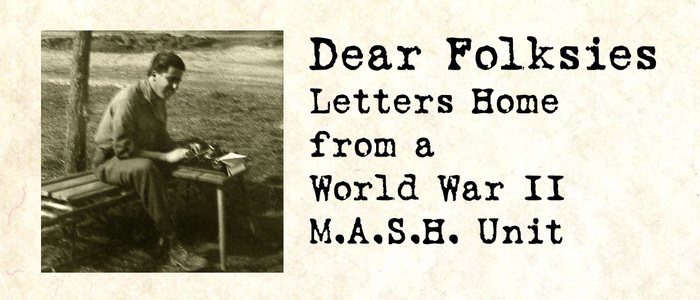September 27, 1945*
Click here to go to San Francisco: October 7, 1945 – October 17, 1945 …
July 9, 1945*
Click here to go to Wabern, Germany: July 10, 1945 – August 23, 1945 …
April 25, 1945*
Click here to go to Heidenheim, Germany: April 26, 1945 – June 5, 1945 …
June 5, 1944*
Click here to go to Anzio, Italy: June 6, 1944 – July 17, 1944 …
October 6, 1944*
Click here to go to Epinal I, France: October 7, 1944 – December 8, 1944 …
September 19, 1944*
Click here to go to Rioz, France: September 20, 1944 – October 6, 1944 …
December 14, 1942*
Click here to go to Sailing the Atlantic: December 15, 1942 – December 29, 1942 …
August 11, 1942*
Click here to go to On the Train: August 12, 1942 – August 15, 1942 …
August 15, 1942*
Click here to go to Camp Kilmer, New Jersey: August 16, 1942 – September 21, 1942 …
June 19, 1943*
Click here to go to North African Convoy: June 20, 1943 – June 25, 1943 …
September 21, 1942*
Click here to go to Camp Pickett, Virginia: September 22, 1942 – November 23, 1942 …
September 12, 1945*
Click here to go to Bad Wildungen, Germany: September 13 – September 27, 1945 …
August 23, 1945*
Click here to go to Fritzlar, Germany: August 24, 1945 – September 12, 1945 …
June 26, 1945*
Click here to go to Ellwangen, Germany: June 27, 1945 – July 9, 1945 …
June 5, 1945*
Click here to go to Dachau Concentration Camp: June 6, 1945 – June 26, 1945 …
March 28, 1945*
Click here to go to Tiefenthal, Germany: March 29, 1945 – April 25, 1945 …
March 16, 1945*
Click here to go to St. Avold, France: March 17, 1945 – March 28, 1945 …
December 30, 1944*
Click here to go to Epinal II, France: December 31, 1944 – March 16, 1945 …
December 8, 1944*
Click here to go to Mutzig, France: December 9, 1944 – December 30, 1944 …
August 27, 1944*
Click here to go to Carpentras, France: August 28, 1944 – September 19, 1944 …
August 14, 1944*
Click here to go to Southern France: August 15, 1944 – August 27, 1944 …
August 10, 1944*
Click here to go to On the Mediterranean: August 11, 1944 – August 14, 1944 …
July 17, 1944*
Click here to go to Battapaglia, Italy: July 18, 1944 – August 10, 1944 …
May 27, 1944*
Click here to go to Naples, Italy: May 28, 1944 – June 5, 1944 …
August 5, 1943*
Click here to go to Sicily: August 6, 1943 – May 27, 1944 …
June 25, 1943*
Click here to go to Bizerte, Tunisia: June 26, 1943 – August 5, 1943 …
December 29, 1942*
Click here to go to Casablanca, Morocco: December 30, 1942 – June 19, 1943 …
November 23, 1942*
Click here to go to Camp Kilmer, New Jersey: November 24, 1942 – December 14, 1942 …
May 5, 1942*
Click here to go to Ft. Ord, California: May 6, 1942 – August 11, 1942 …
October 17, 2020
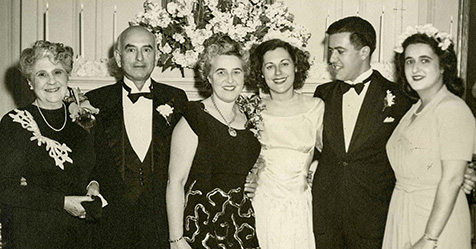
A message from Linda Bine to all Dear Folksies subscribers, Facebook followers and friends, Please accept my sincere appreciation and gratitude for your support since I launched this “blog,” on April 11, 2017, to honor my father and all the members of the 59th Evacuation Hospital. The project has been a labor of love – […]
October 16, 1945

October 16, 1945 San Francisco (Hooray!)…conclusion My dear Yvette, Since being home I have spent most of my time visiting friends and have spent some time out at the County Hospital and at Stanford Hospital trying to find out what opportunities are being offered for further study and hospital work. As yet I do not […]
October 15, 1945

October 15, 1945 San Francisco (Hooray!) continued… My dear Yvette, On Tuesday morning (October 2) we arrived at Camp Beale, which is near Sacramento, about 120 miles north of San Francisco. We soon found out that not only would we be allowed to leave the camp within 48 hours, but that we would actually be […]
October 14, 1945

October 14, 1945 San Francisco (Hooray!) My dear Yvette, At last I have a little free time and am able to sit down and do what I have been wanting to do for the past week, and that is to tell you about the trip home and how perfectly the surprise worked. It couldn’t […]
October 9, 1945
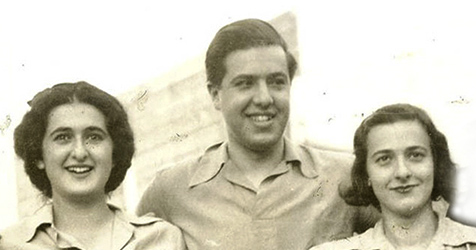
October 9, 1945 San Francisco (Hooray!) Letter to Marie-Louise (conclusion…) From Wilmington, we were told that we would be going the rest of the way by train and that we would probably get out that afternoon or evening. We had arrived at Wilmington at 3:30 A.M. (EST). After getting bunks and unpacking a bit […]
October 8, 1945
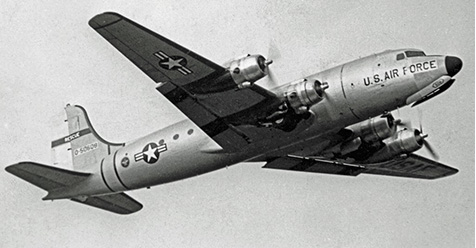
San Francisco (Hooray!) Letter to Marie-Louise continued… In Paris, we were given some dope on how we were going home, about Customs declarations and also a movie on how to conduct oneself in case the plane has to land in the water and be deserted for rubber lift-rafts. It was all most interesting. Every […]
October 7, 1945
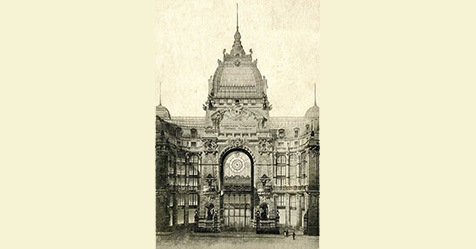
October 7, 1945 San Francisco (Hooray!) Dear M.L. [Marie-Louise, René’s sister, who is living in Puerto Rico with her husband and two children], Have been wanting to write to you ever since arriving home, but you can well imagine how little actual time I have had to sit down at a typewriter without interruptions, […]
September 27, 1945
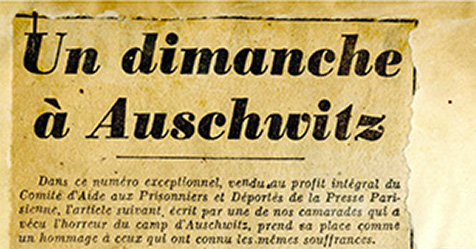
The following is a translation of an article written by Yvette Baumann Bernard, René’s second cousin. A clipping of the original article, which was published in a French newspaper sometime in the second half of 1945 (perhaps on September 27) is reproduced in the sidebar. The preface reads in part, “The following article, written by […]
September 20, 1945
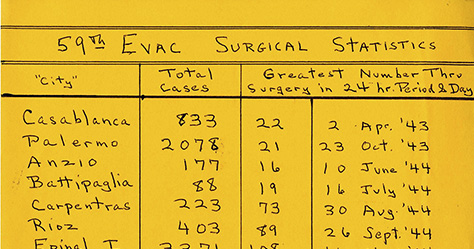
Below is René’s handwritten accounting of the surgical statistics of the 59th Evacuation Hospital – from Casablanca in December 1942 to Epinal II in January 1945. Next letter… * About René & Dear Folksies ⇒
September 14, 1945
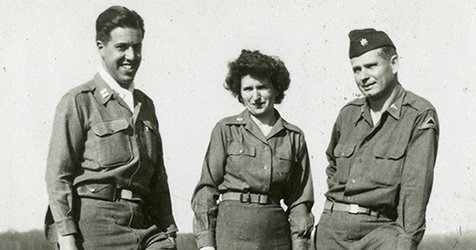
September 14, 1945Bad Wildungen, Germany No. 52 Dear Folksies, Everything is, as usual, a mass of confusion around here. We have now been brought up to strength as far as enlisted personnel are concerned. We received some 40 men from the 91st and then 140 from the 2nd Armored Div. We were supposed to […]
September 13, 1945

September 13, 1945Bad Wildungen, Germany No. 51 Dear Folksies, Well, today we finally moved! We are now in the buildings we should have been in two months ago. We are in the town of Bad Wildungen, which is 14 kilometers from our last spot, and is the town in which the 3rd Division Headquarters […]
September 12, 1945
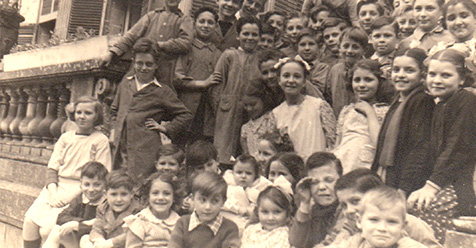
September 12, 1945Near Fritzlar, Germany No. 50 (conclusion) Dear Folksies, What is Yvette doing now? She started an enterprise called “Revivre.” It is her baby and she is the boss. How many she has working for her, I have no real idea; but she is gradually taking care of more and more individuals. Her […]
September 11, 1945
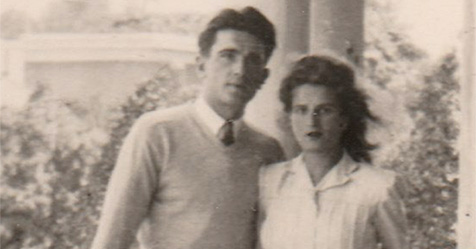
September 11, 1945Near Fritzlar, Germany No. 50 (continued) Dear Folksies, Finally, one day a supposed American Officer (probably a French Liaison Officer with the American Army) arrived in search of some girl. He did not find the girl he was looking for, but agreed that there was no point in going back without anyone. […]
September 10, 1945
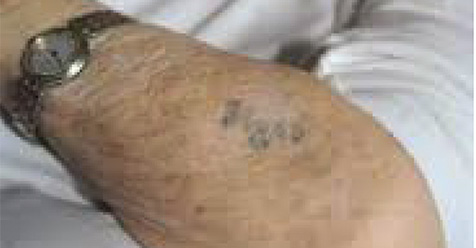
September 10, 1945Near Fritzlar, Germany No. 50 (continued) Dear Folksies, At Auschwitz, they tattooed a number on Yvette‘s arm. Since there are but few women who ever came out of there and returned home, Yvette’s arm is always attracting attention and many questions. She has this tattoo on her left forearm, in the upper […]
September 9, 1945
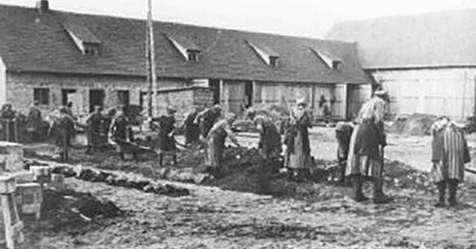
September 9, 1945Near Fritzlar, Germany No. 50 (continued) Dear Folksies, At Ravensbruck, the Germans seemed to have quite a nasty sense of humor or sadism, call it what you will. If a woman had to see the doctor for some internal ailment, she was sent to him completely clothed. If, on the other hand, […]
September 8, 1945

September 8, 1945Near Fritzlar, Germany No. 50 (continued) Dear Folksies, Yvette was taken in a convoy with 1,500 other people to the camp at Auschwitz in April 1944. Of that 1,500, less than ten are now alive. They rode in open flat-cars and part of the time in trucks. When they arrived there, there […]
September 7, 1945
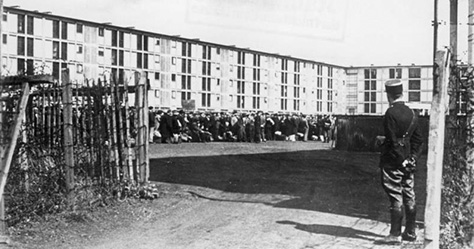
September 7, 1945Near Fritzlar, Germany No. 50 (continued) Dear Folksies, When finally the Gestapo did catch up with Yvette and Jean Guy, they really had all the dope on them, including most of their aliases. When they were confronted with all that information, they knew the jig was up. They were both taken to […]
September 6, 1945
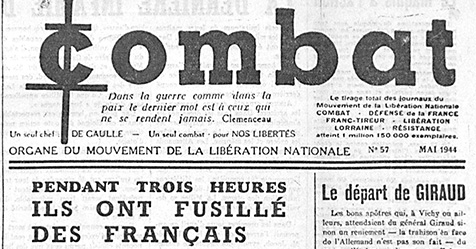
September 6, 1945Near Fritzlar, Germany No. 50 Dear Folksies, Tonight, I’m going to attempt to jot down a few of the things told to me by Yvette and I am not going to try to make this chronological at all. Let me preface my remarks about Yvette by saying that she is truly […]
September 5, 1945

Today we have a letter that Lilice Baumann wrote to René’s parents after his visit to Paris. Lilice is René Sr.’s first cousin. It is transcribed here exactly as Lilice wrote it in English. Dear Ones, First of all I must tell you how happy we have all been when we knew […]
September 4, 1945
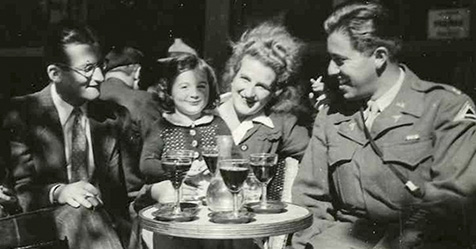
September 4, 1945Near Fritzlar, Germany No. 49 (conclusion) Dear Folksies, After a couple of hours at Weill’s, Lilice and I left, Lilice going home and I going first to the hotel and then to pick up Yvette. Went with Yvette then, to her club, which is called the “18th of June.” Reason for that […]
September 3, 1945
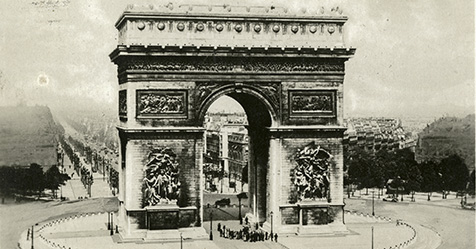
September 3, 1945Near Fritzlar, Germany No. 49 (continued) Dear Folksies, After lunch, walked with Lilice to the Trocadero, which is a beautiful and elaborate place close to the Eiffel Tower, and then finally walked over to Marie Weill’s place. She and her family live on the fifth floor of a rather old, but nice […]
September 2, 1945
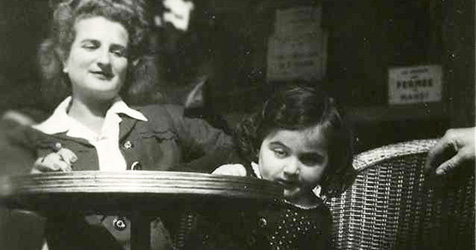
September 2, 1945Near Fritzlar, Germany No. 49 (continued) Dear Folksies, Anthony Sternberg said that the British arrived at his camp [Lubeck POW Camp] on May 2, and he was flown in a C-47 to Brussels. He was supposed to get to Paris from there by train, but the pilot wanted to get to Paris anyway, […]
September 1, 1945
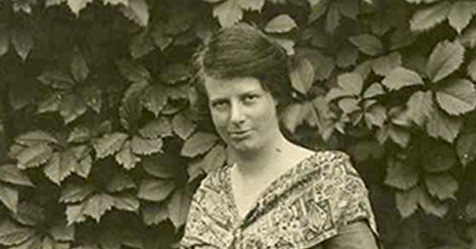
September 1, 1945Near Fritzlar, Germany No. 49 (continued) Dear Folksies, The nite of August 30th, I went to the Sternberg’s for supper. I was greeted at the door by Nicole and Jean-Jacques. Jean-Jacques is 11 years old, has closely cropped red-hair, is smart as a whip and apparently quite a little devil. He is somewhat, […]
August 31, 1945
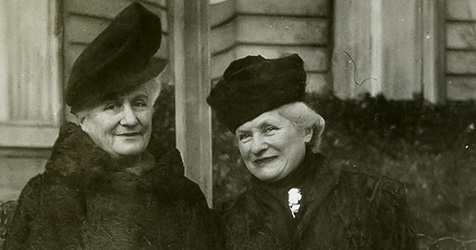
August 31, 1945Near Fritzlar, Germany No. 49 (continued) Dear Folksies, As I said, before quitting on this last nite, I had supper that nite at Lilice’s. I should qualify that, I guess, for the apartment is actually Claudine’s, but all five are living there now, i.e. Giles, Claudine, Dominique, George and Lilice. Anyway, had […]
August 30, 1945

August 30, 1945Near Fritzlar, Germany No. 49 (continued) Dear Folksies, Now I have to tell you about another unpleasant subject – about the tragic manner of Raymond’s death. [Raymond Sternberg was the son of Paulette Leon Sternberg and Anthony Sternberg.] He had been in the Army but 6 months, and had just finished a […]
August 29, 1945
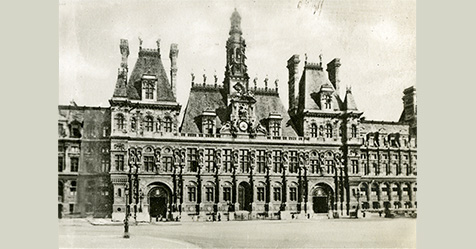
August 29, 1945Near Fritzlar, Germany No. 49 (continued) Dear Folksies, The next A.M., the 29th, I was a bit undecided as to which domicile I should head for first, fearing that some if not all of the family might be away on vacation. So, I finally decided on going to Claudine’s home, feeling sure […]
August 28, 1945
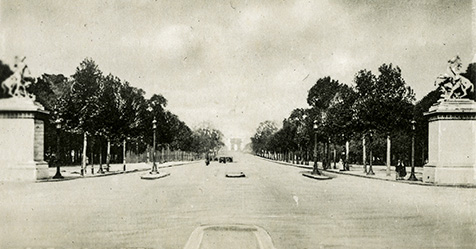
August 28, 1945Near Fritzlar, Germany No. 49 Dear Folksies, I had been moaning for a long time about wanting to get back to Paris, and even had told Col. Yarborough when I first saw him that I wanted to get there if there were any chance. Finally, with the hospital closed because of the […]
August 27, 1945
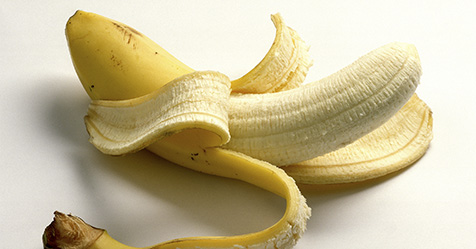
August 27, 1945Near Fritzlar, Germany No. 48 (conclusion) Dear Folksies, Today, for the first time that I can remember overseas, we had fresh bananas!!! And were they good!!! Yesterday 70 more men left us. This gang went to the 5th Armored Division for transportation with them homeward. They should be home by the […]
August 26, 1945
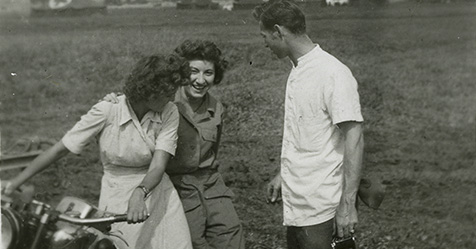
August 26, 1945Near Fritzlar, Germany No. 48 (continued) Dear Folksies, On the nite of August 22nd, we got another surprise – two strangers arrived!! None other than Gil Bishop and Chuck Schwartz. Chuck had heard rumors that we were moving around, that big things were in the wind, etc., and decided that it was […]
August 25, 1945
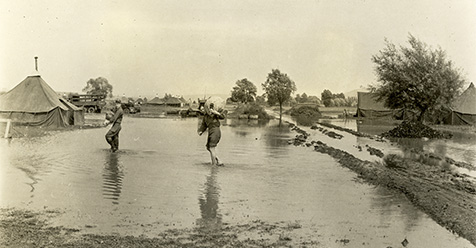
August 25, 1945Near Fritzlar, Germany No. 48 (continued) Dear Folksies, That nite we slept perfectly o.k., but when we awakened we found that there was even more water in the area — the nurses area was inundated, Johnson‘s tent was under about a foot of water, Chatley’s was under a good two feet, and […]
August 24, 1945
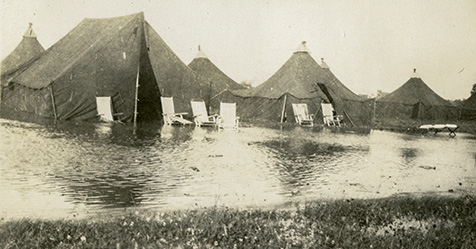
August 24, 1945Near Fritzlar, Germany No. 48 Dear Folksies, Gee, five days has passed now since last writing, but as seems to have been the usual course of events here everything has changed and been re-changed so rapidly that no one knows just what is the score, or if there is a score in […]
August 19, 1945
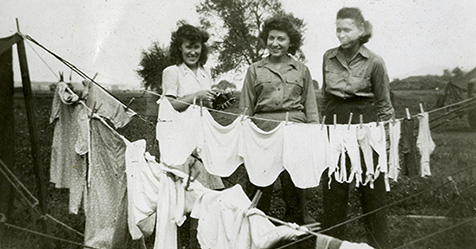
August 19, 1945Wabern, Germany No. 47 (continued) Dear Folksies, Two days ago, came the startling news that all the enlisted men with 99 points or over would leave for home on the 23rd of August. Wow!!! How many of our men does that affect? Only 105 of them! Can we still operate with the […]
August 18, 1945
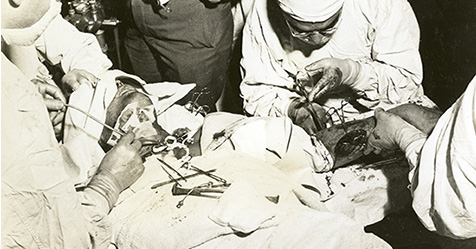
August 18, 1945Wabern, Germany No. 47 Dear Folksies, Nothing more than a thousand new things in the last few days, but what all those things are, or what they mean, you-tella-me! Am at last off Receiving once again — back on the same ward I had when we first came up here, but, […]
August 15, 1945
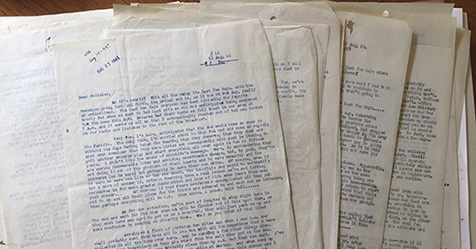
August 15, 1945Wabern, Germany No. 46 V-J Day Dear Folksies, So it’s over!! With all the delay the last few days, with the messages going back and forth, the actual end is, as it was on V-E Day, really an anti-climax. The last two days everyone had been listening for reports hourly, but when […]
August 14, 1945
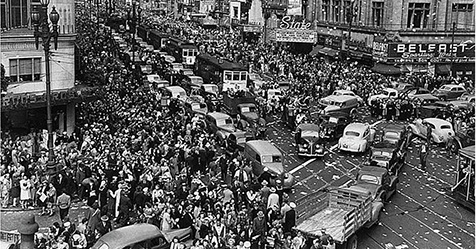
Today we have a portion of the letter that René Bine, Sr. sent to his son on August 14, 1945 – VJ Day, the end of the war in Japan and, therefore, the end of World War II. Anthony’s date with Cleopatra was some event, but at this moment, 6 P.M., it would appear that […]
August 12, 1945
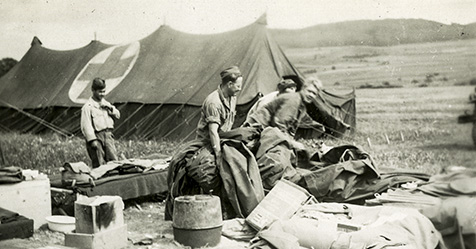
August 12, 1945The Mud-Flats of Wabern, Germany No. 45 Dear Folksies, About the only thing new in the last few days is what all of you know even better — the closeness of the end of the war. Certainly none of us tho’t that things would take such a turn and that we would […]
August 7, 1945
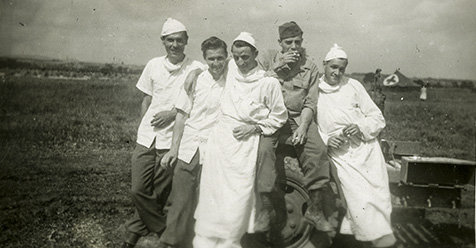
August 7, 1945Wabern, Germany No. 44 (continued) Dear Folksies, After completing the first part of this letter yesterday, I got mighty busy and was kept busy all afternoon. Last nite just after supper, Maj. Mackee asked me if I wanted to do an appendix, so I did, but finally made him take the darn […]
August 6, 1945
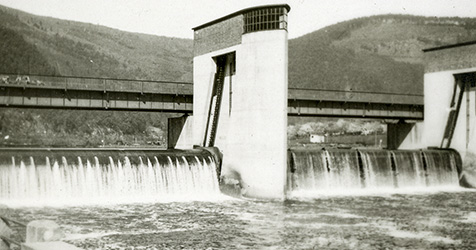
August 6, 1945Wabern, Germany Still in Tents! No. 44 Dear Folksies, Beautiful day today—looks as if ‘tis going to be mighty hot, as a matter of fact. Just hope that business keeps slow enough so that I can pound this typer for a while. We anticipate having Roy and Fadley up here for […]
July 28, 1945
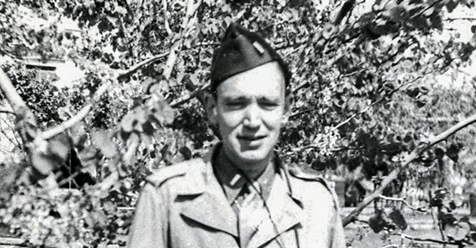
July 28, 1945Wabern, Germany Still in Tents No. 43 Dear Folksies, Things and rumors change so frequently around here these days that it is difficult to keep up on the latest dope. Here’s some of the most recent items: 1) Col. Yarbrough, the C.O., is leaving to go to the 129th Evac., which is […]
July 26, 1945
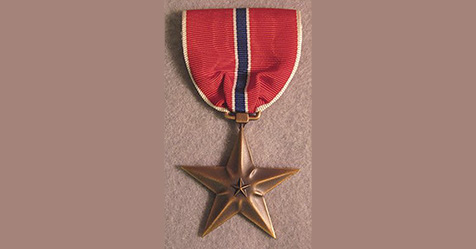
July 26, 1945Wabern, GermanyNo. 42 (conclusion) Dear Folksies, Stories from the other area are terrific. It seems that some of the members of the 108th now disgracing the name of the 59th, are really characters. The Exec Officer in particular! It seems he came in to see Roy one morn and told him he […]
July 24, 1945
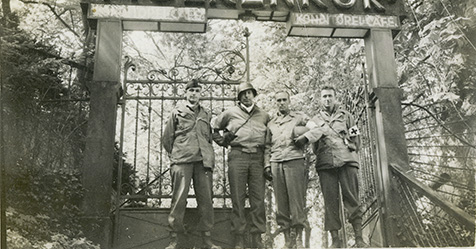
July 24, 1945Wabern, GermanyNo. 42 (continued) Dear Folksies, Annie Dunn dropped from the air onto us the other day. She has been at anesthesia school in Paris – but apparently most of those schools are just chances for good times in whatever city they happen to be. Her course consisted of 2 lectures a […]
July 22, 1945
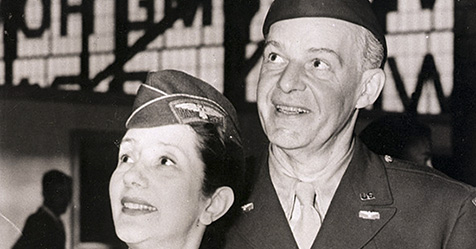
July 22, 1945Wabern, GermanyNo. 42 (continued) Dear Folksies, Last nite, tho’ I had just awakened at 5:30 P.M. feeling as if the whole Russian Army had walked over my tongue barefoot, I finally decided to go with the group to a show. We had gotten a limited number of tickets for the outfit and […]
July 21, 1945
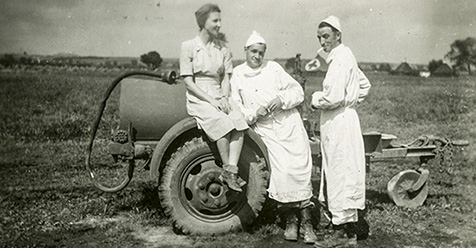
July 21, 1945Wabern, GermanyNo. 42 (continued) Dear Folksies, I was surgical O.D. the other night, and what a night that turned out to be. I didn’t get to bed until 2 P.M. the next afternoon. First we had a guy who ran his hand thru a buzz saw, and tho’ he didn’t do a […]
July 20, 1945
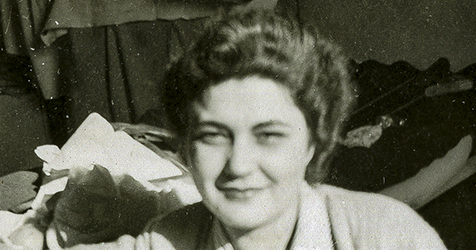
July 20, 1945Wabern, GermanyNo. 42 (continued) Dear Folksies, We are all really griped about the deal the 59th has gotten, because we feel it should be broken up and the 59th dissolved — rather than having a new (and I must say, lousy) gang taking over the name of the 59th. Its only salvation […]
July 19, 1945
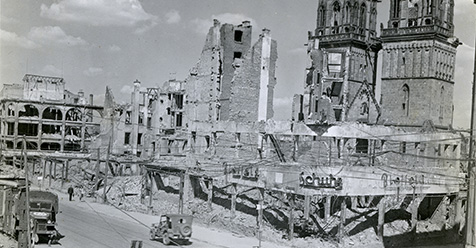
July 19, 1945Wabern, GermanyNo. 42 Dear Folksies, In the last few days we have been mighty busy and it has been so bloomin’ hot that it has been impossible to do much work, particularly around the noon hours. At night one is pretty worn out from the heat and the work that has been […]
July 16, 1945
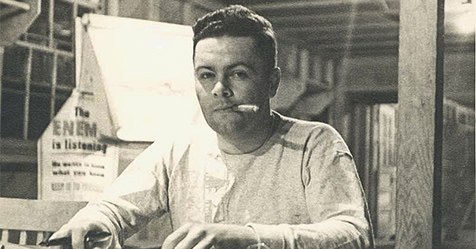
July 16, 1945Wabern, GermanyNo. 41 (conclusion) Dear Folksies, We’ve already sent down two trucks to bring up things that were off the records at the 59th, so that this place could be made to function better — they had the men eating sitting on the ground, even!! We sent for tables and chairs. Their […]
July 14, 1945
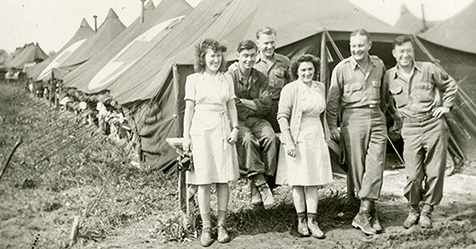
July 14, 1945Wabern, GermanyNo. 41 (continued) Dear Folksies, One of the funniest things we heard about was the distribution of the so-called “Buddy-badge,” the Bronze Star, amongst the members of this outfit. They gave out some 31 Bronze Stars just because they were there to be given out. What a deal! And the 59th […]
July 13, 1945
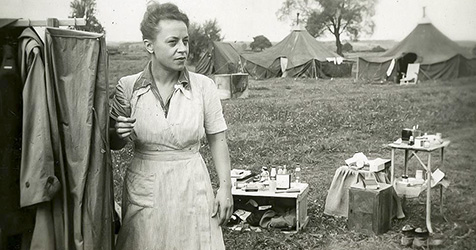
July 13, 1945Wabern, GermanyNo. 41 (continued) Dear Folksies, Yesterday afternoon I spent out hunting for buildings. Not very successful. Came home at 9:30P.M. to find a party in full swing – so celebrated my birthday that way. Pretty good party at that. [July 12, 1945 was René’s 30th birthday.] Of course all sorts of […]
